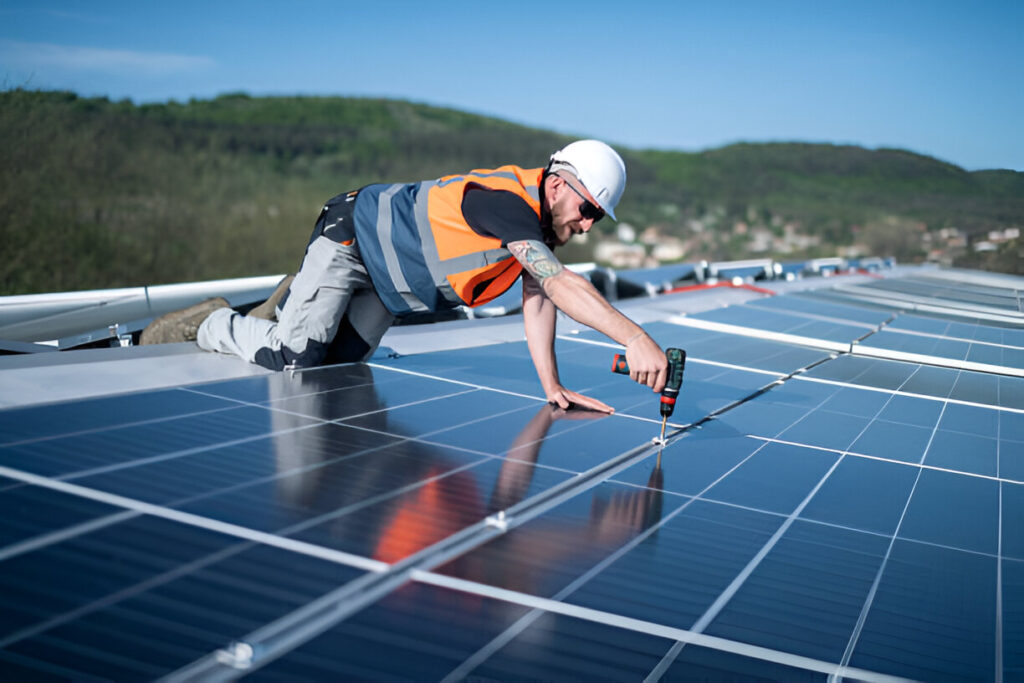
A solar power purchase agreement (PPA) is a financial arrangement where a third-party developer owns, operates, and maintains a solar energy system on a customer’s property. The customer agrees to purchase the generated electricity at a predetermined rate, which is typically lower than the local utility rate. This agreement enables homeowners and businesses to benefit from solar energy without upfront investment in solar panel installation services. Unlike traditional solar ownership, a PPA allows users to immediately start saving on energy costs without the burden of installation expenses or maintenance responsibilities. It is an increasingly popular choice for those looking to transition to renewable energy while avoiding high initial costs.
How a Solar PPA Works
In a solar PPA, the provider installs the solar panel system on a residential or commercial property. The provider remains the system owner and takes care of maintenance, while the property owner pays only for the electricity used. The agreement typically lasts for 15 to 25 years, after which the customer may renew the contract, buy the system, or have it removed. This structure provides a low-risk option for those who want to enjoy the benefits of solar energy without dealing with the financial and technical complexities of system ownership. Since the provider is responsible for system performance, they have an incentive to ensure that the system is well-maintained and operates efficiently throughout the contract period.
Benefits of a Solar PPA
One of the key advantages of a solar PPA is the cost savings. Homeowners and businesses can lock in a fixed electricity rate, avoiding the fluctuations of utility prices. Additionally, since the provider handles maintenance and repairs, there are minimal responsibilities for the customer. This makes solar energy more accessible to those who may not have the capital for a full system purchase. Beyond financial savings, solar PPAs also contribute to environmental sustainability by reducing reliance on fossil fuels and lowering carbon emissions. Many property owners appreciate the ability to go green without the burden of large upfront investments, making it an appealing option for those prioritising both economic and environmental benefits.
Solar PPA vs. Solar Lease
A solar PPA is similar to a solar lease but with a fundamental difference: In a lease, the customer pays a fixed monthly fee for using the system, while in a PPA, they pay for the electricity produced. Many homeowners exploring residential solar installation services opt for a PPA because it ensures they only pay for the actual power generated rather than a set monthly rate. This distinction can lead to greater financial predictability, especially in regions with variable sunlight conditions. While a lease may seem simpler with its fixed payment structure, a PPA can be more cost-effective over time if the system generates high amounts of energy. Both options provide an alternative to traditional solar ownership, but the choice depends on individual preferences and financial goals.
Who Can Benefit from a Solar PPA?
Solar PPAs are ideal for homeowners, businesses, and nonprofit organisations that want to reduce energy costs without a large upfront investment. Those with suitable roofs or open spaces for solar panels can take advantage of a PPA, enjoying clean energy without worrying about system ownership or maintenance. Additionally, PPAs are particularly beneficial for organisations that do not qualify for solar tax credits, as the third-party provider can take advantage of these incentives and pass some savings on to the customer. By eliminating the need for direct system investment, solar PPAs open up renewable energy opportunities to a broader range of property owners, making solar adoption more accessible and cost-effective.
Potential Drawbacks of a Solar PPA
Despite its benefits, a solar PPA may not be the best option for everyone. Some homeowners prefer to own their solar panels outright to maximise long-term savings and take advantage of tax credits. Additionally, transferring a PPA when selling a home can be complicated, requiring approval from the PPA provider and the buyer. While the lower upfront cost of a PPA is appealing, some users may find that purchasing a system outright results in greater financial benefits over time. Furthermore, because a third party owns the system, homeowners do not benefit from increased home equity due to solar ownership. Careful evaluation of long-term financial implications is essential before committing to a PPA agreement.
Choosing the Right Solar PPA Provider
Selecting a reputable solar PPA provider is crucial for a successful agreement. It’s important to research different providers, read customer reviews, and compare contract terms. Working with an experienced solar panel installer ensures that the system is set up efficiently and meets energy needs. Since a PPA is a long-term commitment, homeowners and businesses should carefully examine the contract terms, ensuring transparency regarding energy rates, maintenance responsibilities, and potential system buyout options. Partnering with a trusted provider also guarantees that the installation process is handled professionally, maximising system efficiency and long-term reliability. A well-chosen provider can make the difference between a hassle-free solar experience and unexpected complications.
The Role of State Policies and Incentives
State incentives and policies play a significant role in the feasibility of a solar PPA. Some states offer incentives that reduce costs, while others have restrictions on third-party ownership of solar systems. Understanding local regulations can help homeowners and businesses make informed decisions about entering a PPA. In states with strong solar incentives, such as tax credits and net metering programs, PPAs can be even more beneficial, further lowering electricity costs. Conversely, in regions with less favourable policies, other solar financing options may be more attractive. Being aware of the state’s renewable energy policies ensures that property owners maximise their potential savings and avoid unexpected legal or financial challenges.
Finding the Best Solar PPA Provider in Maryland
Maryland is known for its strong solar policies and incentives, making it an excellent location for solar PPAs. Homeowners and businesses should research the best solar companies Maryland to find a reliable provider that offers competitive rates and quality service. Comparing different offers and contract terms can help in securing the most cost-effective agreement. Maryland’s Renewable Portfolio Standard (RPS) and other solar-friendly regulations make the state a prime location for adopting solar energy through PPAs. By working with top-rated providers, residents can ensure they receive high-quality service and the best financial benefits possible, making solar energy a smart and sustainable choice for the long term.
Conclusion
A solar power purchase agreement (PPA) is a practical way for homeowners and businesses to access solar energy without significant upfront costs. By partnering with a reliable provider, property owners can enjoy lower energy bills, reduced carbon footprints, and minimal maintenance responsibilities. Whether opting for a PPA or considering alternative solar financing options, understanding the terms and potential savings is essential to making an informed decision. Solar PPAs provide a viable route to renewable energy for those looking to save money while supporting environmental sustainability. With careful consideration and research, property owners can leverage solar PPAs to enhance energy efficiency and contribute to a greener future.



